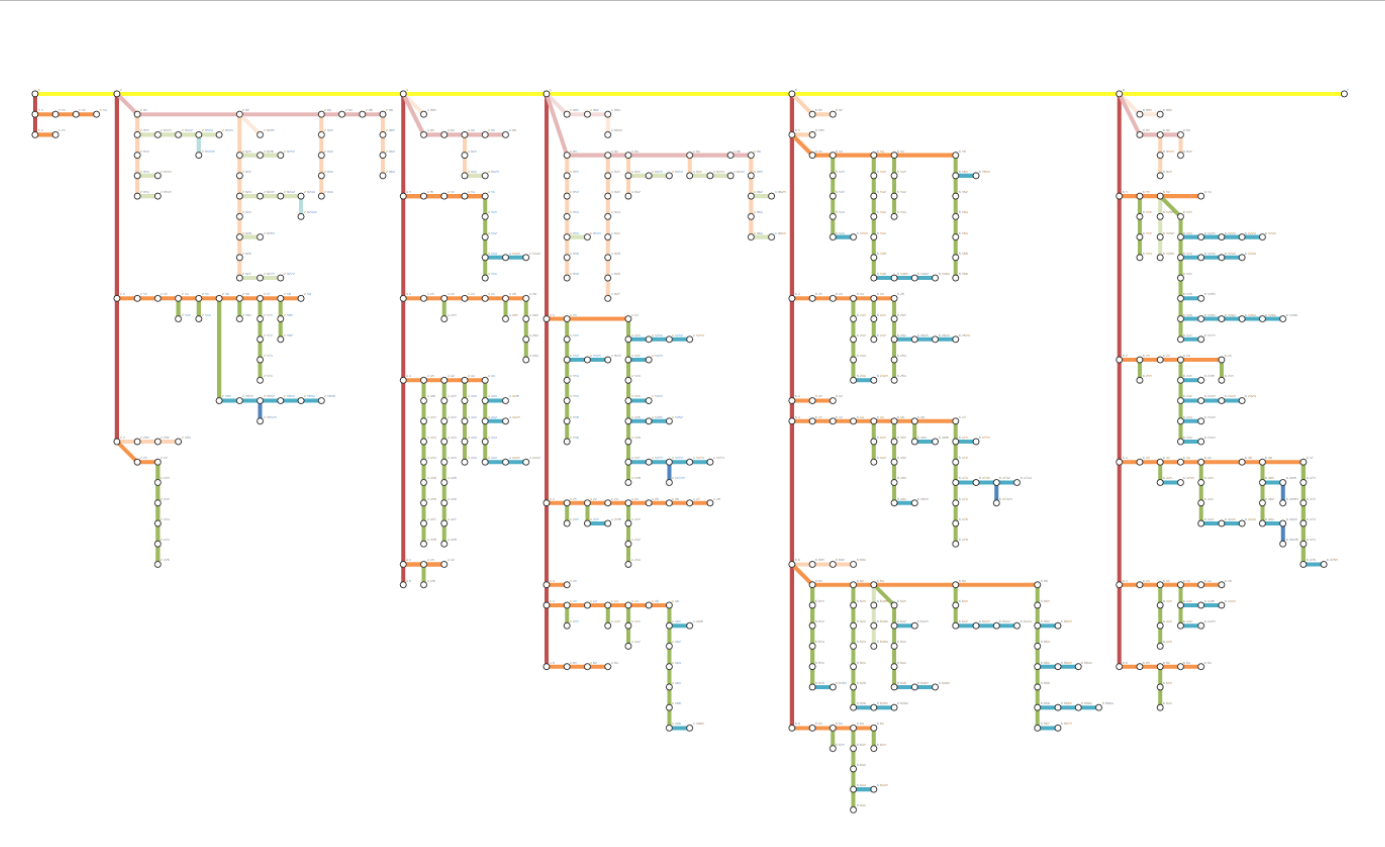The Tractatus As Subway Map
Last year I posted about visualizations of Wittgenstein’s Tractatus. There’s now a new one. David Stern (University of Iowa) writes:
I asked the students in my Wittgenstein seminar if they could come up with a better way of visualizing the structure of the Tractatus, and one of them proposed looking it as a subway map, rather than a tree, which turned out to be a very productive suggestion. I turned his pencil and graph paper into an Excel spreadsheet, and we ended up collaborating on a Tractatus (and Prototractatus) map website with our University Library’s Digital Design Studio.
–
The results of this collaboration are now online, with an introductory page with the links to their subway-style versions at the top, an explanation of how to use it, and links to various other versions. It’s pretty well done, and includes options to look at the original and translated text. Here’s what the Tractatus map looks like:
Professor Stern continues:
The overall aim of the project is to provide a resource that will be useful to readers and researchers. We’ve tried to make it attractive to look at, and also easy to navigate. In the future, we plan to add some more features, without taking away from the relatively simple interface.
Any suggestions you, or you readers, may have for changes or improvements, or questions about how it works, would be very welcome.



HNNNGGGGH
Wittgenstein’s Tractatus lends itself to the map analogy, as my old professor, Farhang Zabeeh, pointed out back in my grad school days of the 70’s. Witt. himself refers to maps and the analogy in his works. But the subway map is a great analogy, beyond just maps in general. Nice.
Nice, but in my browser (Chrome) the top line of the map doesn’t show. Can the map be moved down on the page slightly?
Once in one of the map windows–you need to click on the “Prototractatus” and “Tractatus” links at the top of the introductory page to get there–the top (yellow) line should be at the top of the screen when you open a map window. If not, you can move the whole map by clicking on the white space and moving your mouse.
If this doesn’t clear things up for you, please email me ([email protected]) with a screenshot, if possible, or more information about your setup (e.g., the OS, and screen size). It does work in Chrome in the setups we’ve tested.
But it’s still a tree (i.e. connected and acyclic) – you don’t have too complex subway transfers.
Yes, our map does have a tree-like structure, but it differs from previous “logical tree” hypertexts in two important respects. (We do link to all the other online editions of the Tractatus that we know of at the end of our front page, if you’d like to take a look at them.)
First, it is possible to look over our subway maps as a whole, and to examine the structure of each part. Conventional tree diagrams are much more visually complicated, so much so, that they are normally only used to show a small part of the structure at one time. To use a favorite term of Wittgenstein’s, a subway-style map of the Tractatus is surveyable, while conventional tree diagrams that try to show the book as a whole are not. This is not just a matter of being appealing to the eye. The surveyability of our map makes it possible to take in the structure of the book as a whole, and I believe this can be helpful in thinking about its argument and organization. For instance, the Prototractatus map makes it possible to visualize the gradual addition of material to the growing book draft, as one gradually increases the “end page” value from 1 to 103. (Undocumented and slightly buggy bonus feature: set the Prototractatus “start page” and “end page” to 1, and then repeatedly press the “Enter” key, to watch a flip-book style animation.) Or just select an end page of 70, to see what the book draft looked like at a fairly late stage in the composition process, but before the inclusion of the famous final remark, number 7.
Second, the architecture of our map is a little different from most previous tree-style diagrams when it comes to the handling of the relationship between remarks containing zeros and the remarks they comment on. We do not insert nodes/stations such as “3.0” and “3.00”, which do not occur in the Tractatus, to connect 3 with 3.01 and 3.001. (Nor do we have a node numbered “0” as the root of the tree from which nodes 1-7 branch.)
I love it! Pictorial representations can be so helpful. I was surprised to learn that some philosophers are snobby about them, as though representing an ideas in language and formal symbolism are the only philosophically respectable ways to express them. I wonder if we could also take a leaf out of Diogenes’ book, and start enacting more of our arguments. I am probably speculating off the deep end here, but perhaps we could consider certain political actions to be a form of philosophical argument?
Ugh, typo. Obviously the “an” between “representing” and “ideas” shouldn’t be there!
beauvoir’s baby you might find Philosophy Unbound’s events interesting in this regard http://philosophyunbound.tumblr.com/about
Interesting, thank you.
Any chance of a map for PI etc?
In case you want to dig deeper, Peter Hacker’s “How the Tractatus was meant to be read” (http://philpapers.org/rec/HACHTT, i.e. as a tree) and my (shameless self-promotion, I’m sorry) “How to read the Tractatus sequentially” (forthcoming at Nordic Wittgenstein Review, http://philpapers.org/rec/KRAHTR, i.e. not as a tree) may be useful starting points.
Thanks very much for this helpful follow-up about the recent debate over how best to understand the numbering system of the Tractatus and its implications for reading and interpreting the book, and for the link to your valuable paper responding to the Bazzocchi and Hacker interpretation of the numbering system. Readers wanting to dig deeper still can be assured that the bibliography to Tim’s paper is a good guide to the relevant literature on this topic. Another good starting point is Verena Mayer’s 1993 paper on “The Numbering System of the Tractatus”. Ratio 6, pp.108–120, which has not yet received the attention it deserves.
Because we (I and my collaborators working on the UI TLP site: Phillip Ricks and Landon Elkind) envisage the map as a tool that we would like a wide variety of readers to find helpful, rather than advocacy for a particular interpretation, we avoid taking a stance on issues of interpretation on the site. But of course we are ultimately interested in issues of Tractatus interpretation, and all of us are working on related philosophical projects.
My in-depth discussion of the Tractatus map project has just been published in the current issue of the open-access Nordic Wittgenstein Review 5:2 (2016) 203-220, under the title “The University of Iowa Tractatus Map”, and includes a brief response to Tim Kraft’s paper, which is included in the same issue. See:
http://www.nordicwittgensteinreview.com/
Here’s the abstract:
Drawing on recent work on the nature of the numbering system of the
Tractatus and Wittgenstein’s use of that system in his composition of
the Prototractatus, the paper sets out the rationale for the online tool
called The University of Iowa Tractatus Map. The map consists of a
website with a front page that links to two separate subway-style maps
of the hypertextual numbering system Wittgenstein used in his
Tractatus. One map displays the structure of the published Tractatus; the
other lays out the structure of the Prototractatus. The site makes
available the full text of the German and the two canonical English
translations. While we envisage the map as a tool that we would like a
wide variety of readers to find helpful, we argue that our website
amounts to a radically new edition of Wittgenstein’s early masterpiece,
with far-reaching implications for the interpretation of that text. In
particular, we claim that our visually compelling presentation of the
book’s overall structure delivers on Wittgenstein’s cryptic claim in a
letter to his publisher that it is the numbers that “make the book
surveyable and clear”.